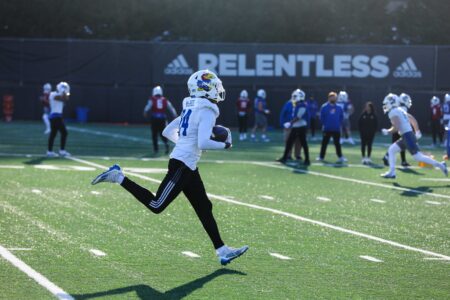Column: Thin blue line: Kansas better, but building O-lines takes time

Kansas University Ngalu Fusimalohi, (63) participates in drills during a team practice Thursday, August 14, 2014.

Kansas University Ngalu Fusimalohi, (63) participates in drills during a team practice Thursday, August 14, 2014.
In Major League Baseball, a shoddy pitching rotation is the snowflake that gains steam through the course of a season and turns into a lethal avalanche.
By August, bullpens are worn out, sore arms crop up all over the place, and the team fades into oblivion.
Teams with solid starting rotations that enable managers to keep their bullpens fresh are the ones to watch in August, so it’s no big surprise that the Kansas City Royals, with not only a talented bullpen, but a fresh one, are 13-3 heading into tonight’s game in Minneapolis. Eight of the 12 victories came in games in which the Royals held the opposition to two or fewer runs.
A bad offensive line can tear apart a football team the same way a starting rotation can in baseball. Quarterbacks and running backs take beatings. Injuries mount. In some cases, the guys with the ball in their hands instinctively duck for cover. Defensive linemen know they’ll get rewarded for teeing off, so it fills them with energy.
For a Kansas University football team that looks better on defense and so much better at wide receiver than in Charlie Weis’ previous two seasons as head coach, the state of the offensive line stops me from believing those gains will add up to a bowl bid.
It doesn’t take a village to build an offensive line, but it does take time. Even at the elite college football schools, it typically takes a couple of years for the most talented blockers to emerge from the weight room and get their minds fully trained for more difficult, exhausting football practices than they ever have experienced.
Weis didn’t have that luxury when he inherited a roster extremely thin on offensive linemen, so he went the junior-college route and in the process might have passed on a high school player or three who doesn’t yet look like a Div. I blocker but could grow his body and mind into the challenge in two or three years’ time.
Unfortunately for KU, offensive line is the position that translates the worst from junior college to big-time college football. KU offensive coordinator/O-line coach John Reagan is widely respected among his peers for coaching up blockers, but doing is a slow process that works best with players who spend five years in the program, not two.
Weis said he expected decisions to come by about now on where the linemen will play, which leaves at least a little time for the blockers to develop chemistry with the guys grunting their way through swollen-knuckle days.







